#juniper white
Explore tagged Tumblr posts
Text

Costumes 2023 • Descendants OCs Edition
Juniper White as Elle Woods - You must always have faith in people. And, most importantly, you must always have faith in yourself
Taglist : @randomestfandoms-ocs @eddysocs @that-demigirl @impales @ocfairygodmother If you want to be added send me an ask! 💚
#greta's costumes project 2023#ocappreciation#ocapp#allaboutocs#fyeahdescendantsocs#fyeahdisneydescendantsocs#juniper white#my ocs
7 notes
·
View notes
Text
hey rember the aa meme series on my old account
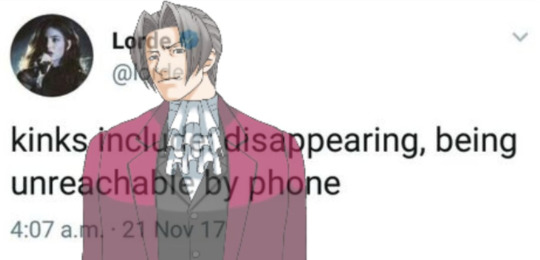


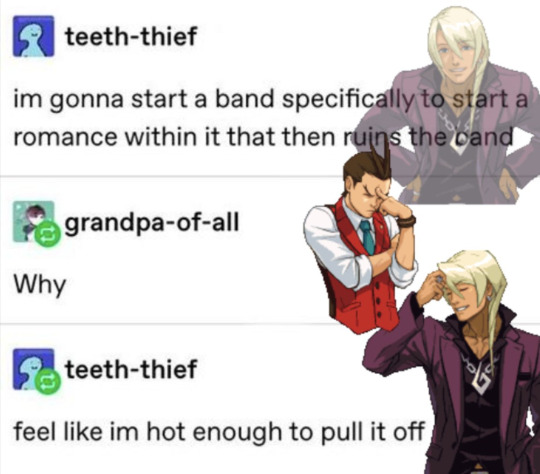



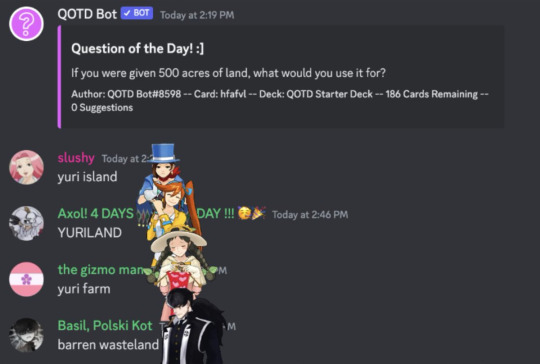



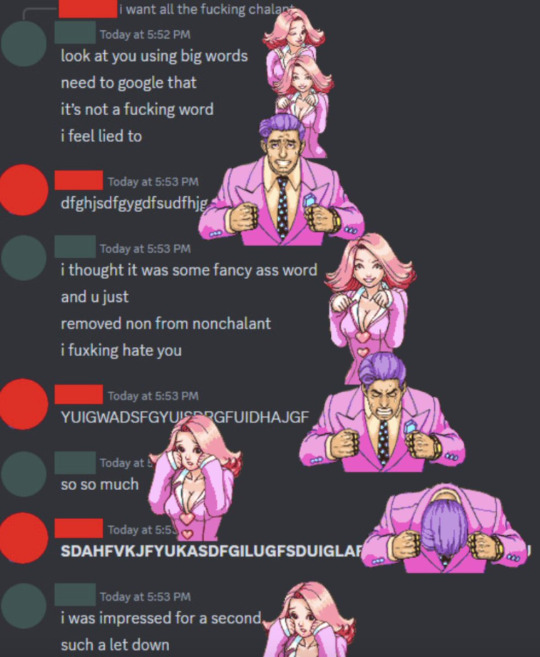
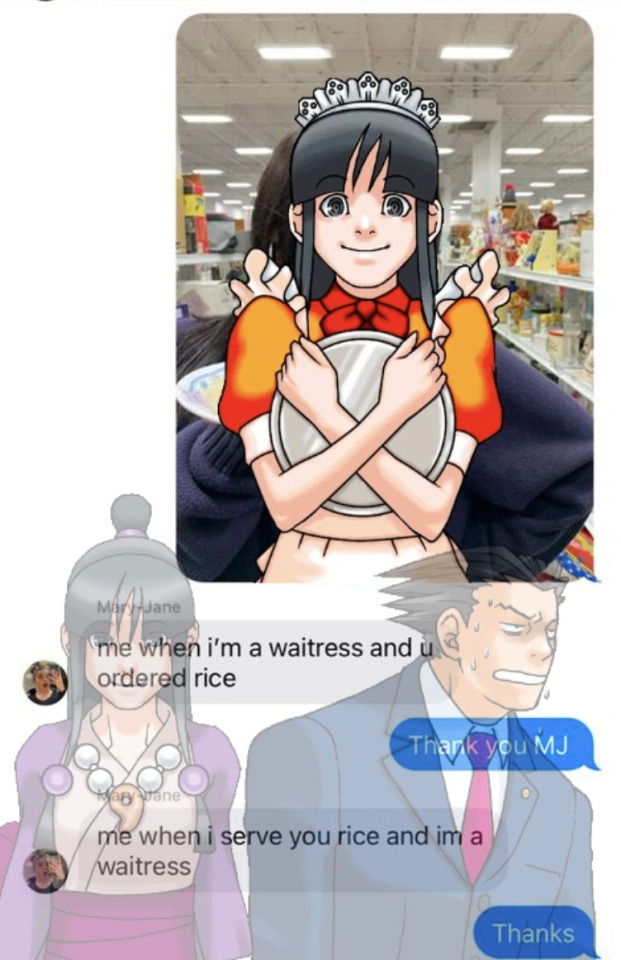
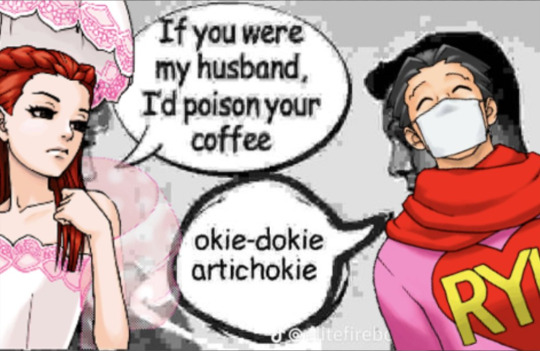


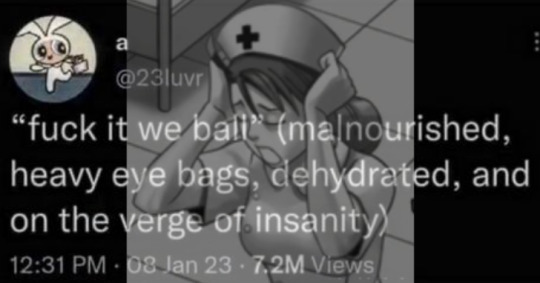
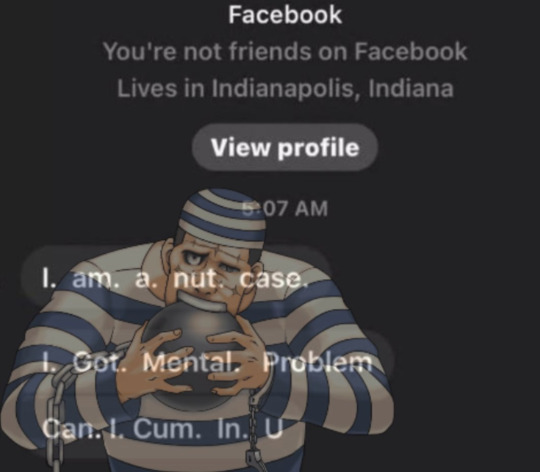


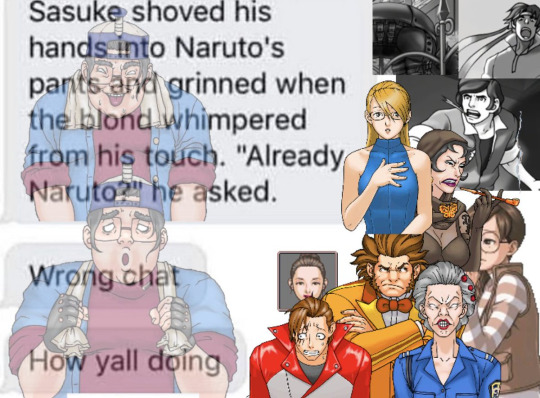

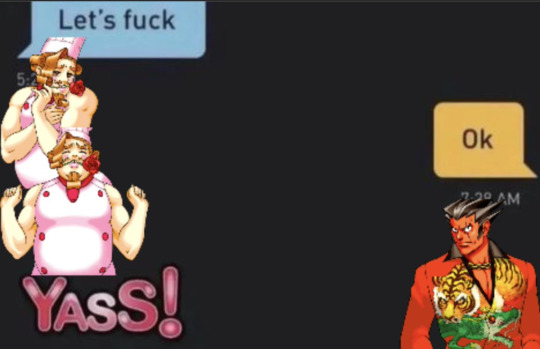

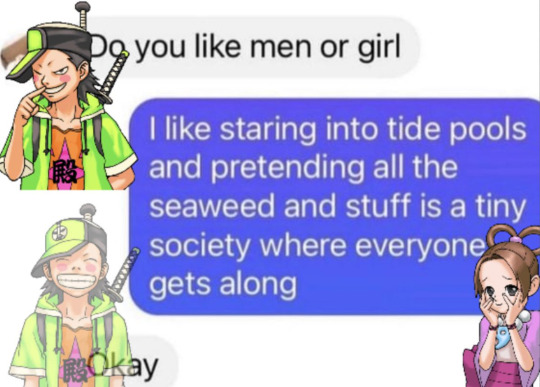
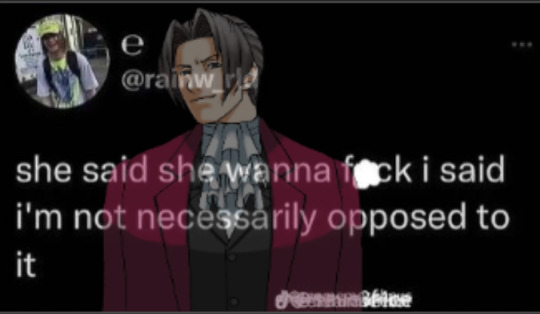
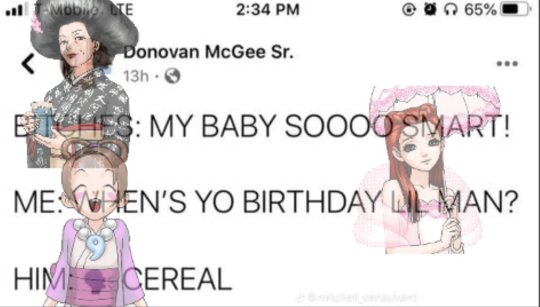
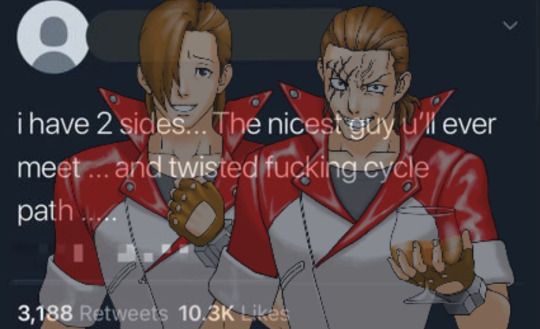
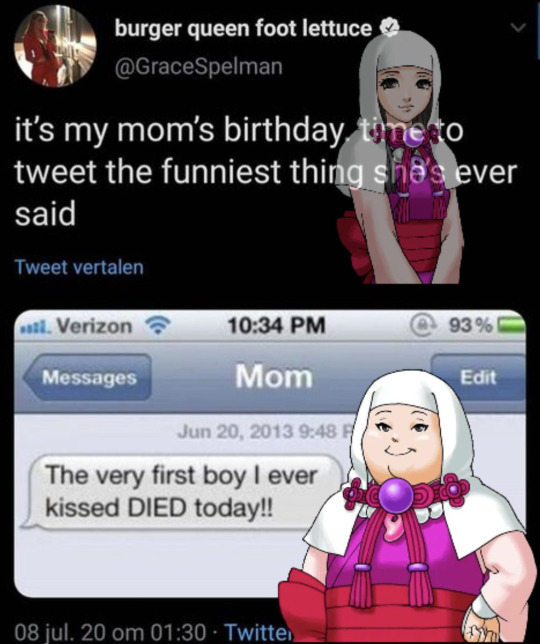

#ace attorney#ace attorney textposts#miles edgeworth#phoenix wright#april may#lotta hart#klapollo#klavier gavin#apollo justice#matt engarde#krisnix#kristoph gavin#beanix#beanix wright#dahlia hawthorne#trucy wright#athena cykes#juniper woods#simon blackquill#redd white#maya fey#feenie wright#feenie#larry butz#narumitsu#franmaya#franziska von karma#fvk#mimi miney#terry fawles
2K notes
·
View notes
Text

The result of today's stream ~
They're so sweet qwq
1K notes
·
View notes
Text

Japanese Garden Juniper
Bonsai & Penjing Museum, Washington, DC
photo: David Castenson
466 notes
·
View notes
Text
look who’s bored again. me, i am. have some pjo side character incorrect quotes because i love them so much.
~
Paolo: what does “Take Out” mean?
Connor: Food.
Valentina: Dating.
Laurel and Holly: Murder.
Sherman: all three if you’re not a coward!
Connor: Me and Malcolm were playing Scrabble and it was a nightmare.
Juniper: Scrabble? Scrabble’s great.
Connor: Not when you’re playing with Malcolm. He puts words like “ephemeral” and I put “dog.”
Mitchell: you’re petty.
Drew: you mispronounced ‘pretty’ but okay.
Ellis: crushes are the worst!
Cecil: yeah, whenever I’m near mine, I start acting stupid.
Ellis: pfft you’re always stupid.
Cecil: yeahhh, don’t think about that too hard.
Ellis:
Travis: if we put Luke, Thalia and Annabeth in a room, who do you think would come out crying first?
Connor: the room.
Jake: did you hear? Luke was almost hit by an arrow in training today!
Michael: I know. He was faster than I thought.
Jake:
Michael: don’t worry, I’ll get him next time.
Malcolm: gods, this is the dumbest thing I’ve ever done!
Drew: aren’t you dating Connor?
Connor: that was uncalled for!
Mitchell: I want to be like a caterpillar.
Clovis: Explain.
Mitchell: eat a lot, sleep, wake up beautiful.
Clovis: you do know you would have a lifespan of about a week?
Mitchell: another highlight.
Katie: did you know cereal is basically cold breakfast soup?
Connor: *drops cereal bowl*
Travis: STOP SCARING THE KIDS KATIE!
Laurel: the risk I took was carefully calculated.
Billie and Damien: WE ALMOST DIED!
Laurel: I never said I was good at maths.
#I should stop#but like I’ve got so many incorrect quotes just in my notes it’s not even funny anymore#and when I’m bored I just post them with whichever hyperfixation I’m feeling that day#can anyone tell I love these side characters sm??#percy jackson and the olympians#heroes of olympus#trials of apollo#connor stoll#travis stoll#katie gardner#drew tanaka#malcolm pace#cecil markowitz#ellis wakefield#laurel victor#holly victor#billie ng#valentina diaz#paolo montes#damien white#mitchell pjo#clovis pjo#michael yew#jake mason#juniper pjo#sherman yang#incorrect percy jackson quotes#there’s like a bit of my fav ships sprinkled in here#like malconnor#and tratie and cellis and clovis x mitchell and jake x michael
187 notes
·
View notes
Photo

106 notes
·
View notes
Text
Connecticut dog but in rwby




#rwby#jaune arc#weiss schnee#white knight#rwby shitpost#whiteknight#rwby whiteknight#nightmare weiss#nightmare knight#connecticut clark#rwby juniper
168 notes
·
View notes
Note
A whiteknight ask:

They found something that their parents should have hidden somewhere else
"Oh, my Gods!!" Juniper Arc-Schnee screeches in horror, stepping back from her parent's closet. "What the crap?!"
"Oh, balls," Jaune grimaced as his daughter found a BDSM version of the Rusted Knight armor. "Uh, your mother's a huge fan--."
"CLEARLY!!" Juniper turns around, marching out of her parents' room.
#answer#answered#answers#answer post#answered post#rwby#rwby au#rwby shitpost#rwby fic#rwby fanfiction#jaune arc#oc: juniper arc-schnee#rwbabies#whiteknight#rwby whiteknight#white knight#rwby white knight#source: dc comics#source: superman#future au#parents au#domestic au
94 notes
·
View notes
Text

Juniper (@seabeck 's dog) Amongst Marsh Marigolds
#artists on tumblr#original photographers#original photography#hiking#pacific northwest#nature#washington#nikon#pnw#orofeaiel#juniper#flowers#white marsh marigolds#spring#pet portrait#springer spaniel#majestic#doggo#dog
121 notes
·
View notes
Text
Jaune: Wait... that's me?
Jaune points to a smirking CatJaune.
Jaune then points to Weiss.
Jaune: What the hell did you do to me!?
Weiss: I did nothing!
Juniper: 🐇
Jaune: Yeah, you're right, girl, Trivia won't like me like that.
Weiss: Now isn't the time to badger me! I need to save my knight.
Jaune: Aww, so you two are together in this universe.
Juniper: 🐇
Jaune: Hey, now, no one, not even Weiss 2 can replace my Trivia... don't tell her I said that.
Juniper: 🐇
Jaune just groaned as Juniper hit him on the head with one of her ears.
Weiss: Can we focus on the task at hand and fight my possessed boyfriend!
CatJaune tapping his foot with his arms crossed.
CatJaune: Are you three done yet?
Jaune: Alright, other me! Prepare for violence...uh...gosh, this is weird.
Jaune raised his sword and pointed it at his evil self right as Juniper vanished in a flurry of golden light before said light covered Jaune in a suit of armor.
64 notes
·
View notes
Note
BROTP ask meme for Juniper White and whoever her bestie is? 🖤
Yay, Juniper ask! Ben is her bestie! (Which is hilarious, with some spoilers and context)
who steals french fries off the other’s plate: Ben
who jokingly moves in for the kiss when someone asks if they’re a couple: Neither (actually, they're both pretty disgusted by this question lmao)
who has to bust or bail the other out of jail: Juniper (but nobody would really end up in jail tbh)
who gives the other advice/comfort about dating issues: Ben (or at least he tries)
who shamelessly cheats at games by reaching over to cover the other’s eyes: Ben
who immediately calls dibs on the top bunk: Juniper
who starts and who wins the pillow fights: Ben
who says “your pants would look better on their floor” to the other’s potential crush: Neither, I think
#answered#oc related ask#juniper white#about juniper#juniper & ben#brotp questions ask game#faerieroyal
2 notes
·
View notes
Text
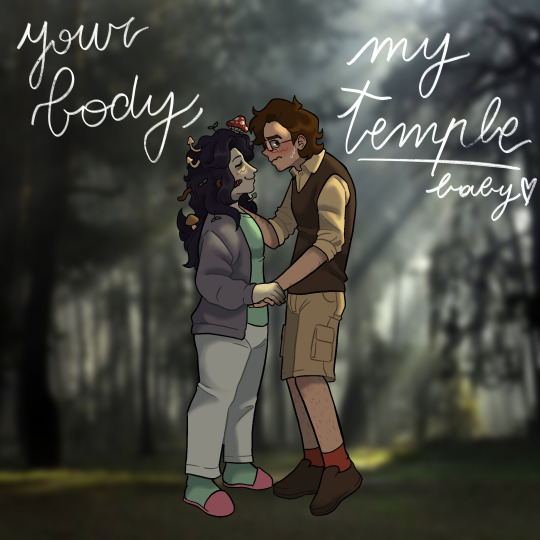

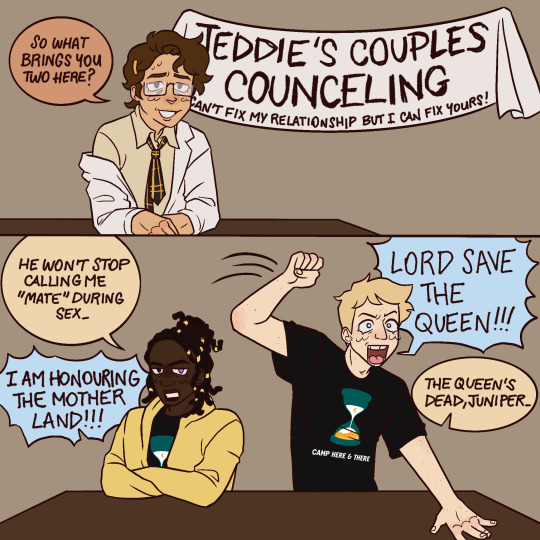

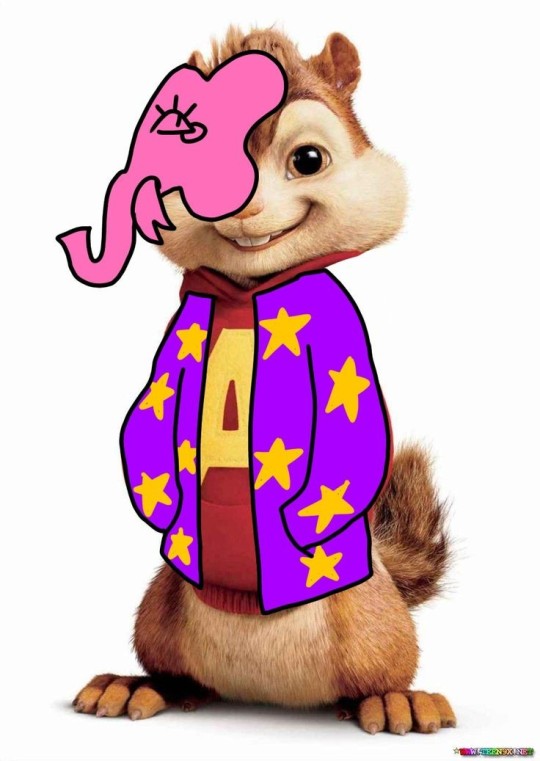
Please someone tell me this podcast has a fandom I'm losing my mind all alone in the woods in a wet cardboard box
Edit:
Apparently I made a GRAVE mistake in this. Marisol is much taller than salem!!! I did not. Know that!!!! Sorry lesbians
#art#artists on tumblr#camp here and there#will wood#sydney sargent#chnt jedidiah#chnt#chnt fanart#chnt art#elephant man#elijah volkov#rowan chow#juniper sloan#jeddie#rowen x juniper#salem de la marnierre#marisol yuchengco#joshua macheath#yvonne marley#do not talk to the white man in the woods#he will try to rizz you up#ugly russian fucker
525 notes
·
View notes
Text
𝒎𝒖𝒔𝒉𝒚 𝒎𝒂𝒚 𝒅𝒂𝒚 5: 𝒂𝒏𝒊𝒎𝒂𝒍𝒔
words: 911 pairing(s): mountain + hank the raccoon/juniper the cat catch up on the hank lore [here] and [here] and [here]
✿
A thumbtack. An acorn. A loose ribbon. A big lilypad snatched from the lake. Pebbles, flowers, and petrified chips. Even a lost earring without its twin, the worn gold star glinting from where it’s buried in the pile of random trash and trinkets.
Mountain stares. The only reason he noticed it at all was because he had to scoot out the storage cabinet to get to the stone planters. He sets down the tower of pots he was shuffling from one end of the greenhouse to the other and wipes his hands on his apron. Curiosity reels him in; he squats down to inspect the squirreled-away pile of things at closer proximity.
The little stash is actually quite unique. Hardly any duplicate objects besides the pebbles—even the dried blooms differ from each other. Mountain pokes around some of the objects with his finger, rummaging for the more buried items. A broken plastic bubble wand. A scrunchie. Part of a grucifix. A cork. Even a guitar pick. And . . . are those . . ?
“My glasses?!” Mountain frees them from the pile and stares at everything open-mouthed. He’s been looking for them for weeks; swore he left them in here, just on the bench, but when he had come back the next day they were gone. He had come to terms with having to get a new pair (though he quite liked these ones)—and yet, here they are.
There’s a rustling behind him, and when a round little body toddles up to him, the puzzle pieces click into place.
“Hank,” the earth ghoul accuses. He dangles the pair of readers in front of the raccoon’s twitching nose. “Why’d you steal my glasses, dude?”
Hank chitters and whips his fluffy tail back and forth, ears pinning back to his head.
Mountain sighs and offers him a scritch under the chin. Too cute to stay mad. “I’ve been blindly potting flowers for many days, little one,” he scolds, albeit with a kinder tone.
The animal squawks and pushes past Mountain’s legs to his trinket stash. He whines when he sees the state of it, all scattered about and disorganized.
“Well you can’t blame me for wanting to look,” the earth ghoul defends himself. “You’re not stealing from other people, are you?”
Hank screeches at the accusation.
“Sorry, sorry. Just me then, hm?” He gets screeched at again and bapped in the shin with Hank’s tail.
Lucifer give him strength, he’s arguing with a raccoon. “Okay, let’s just say you found them, then.”
Hank is pleased with this answer. He chirps and begins to re-arrange his items.
“Why do you have all this anyway? I mean, I’m a lover of a good trinket myself, but you aren’t exactly the collecting type of species . . . also I’m not sure that all of these things count as trinkets.”
The animal gives him the best side-eye a raccoon can muster.
“Hank, there’s a dead bumblebee in here.”
If a raccoon could roll its eyes and lift its chin indignantly, Hank would do that. Instead, he chitters what can only be a string of small mammalian passive aggressive statements.
“There’s no need for such language.”
Hiss. Chirp chirp.
Mountain rubs at the bridge of his nose. “I’m not saying you can’t—listen. Little one. My darling. Little. Creature.” He emphasizes each word with a sigh, chopping his pressed-together palms down as punctuation. Hank stops fussing with his objects and looks at the earth ghoul with those black little orbs. “Could we, perhaps, just find a better place for them? Put them somewhere I’m not going to accidentally crush them with an old armoire, yeah?”
The animal screes happily, bouncing over to the earth ghoul and standing up with his little hands outstretched. Mountain snorts and picks him up, rising back up to his feet and flipping him over to rub his belly.
“Why do you have to be so cute?” he asks, playfully pinching under Hank’s chin. The raccoon only kicks up a scratchy purr in response, swatting at Mountain’s wrists weakly. Mountain bounces him like a baby for a few moments before setting him down again, glancing around for something to use for his friend’s treasures.
“Hm. I think there’s an old basket or . . . something around here,” he mumbles. He taps his hands on his apron as he scans the rows of tables and shelves. No . . . no . . . no. Suddenly, Mountain stops. Scrunches his face up and turns back towards Hank fully confused.
“Why are you hoarding things anyway?”
As if to answer his question, Juniper squeezes her way through the back door. Mountain had put a kitty door in it for her and Hank—though, Hank still prefers to force himself through the gap in the opposite corner of the green house where the windows have bowed out throughout the years.
The white cat offers a mrrow in greeting, striding up to the both of them with an unbothered, graceful aire. Hank chitters excitedly and bounds over to his pile of trinkets, quickly selecting a mystery bauble between his thin little paws. He shoves it in his mouth and runs over to her side, chirping in greeting and dropping the object at her feet.
A close-to-fresh dandelion. Juniper mrrp’s at the gift and leans down to inspect it, the buttercup yellow petals tickling her nose. She seems pleased with the gift and rubs her cheek affectionately against Hank's with a purr. Two little unlikely lovebirds.
“Ah. Should have guessed that’s who those were for . . .”
𝒑𝒍𝒆𝒂𝒔𝒆 𝒄𝒐𝒏𝒔𝒊𝒅𝒆𝒓 𝒓𝒆𝒃𝒍𝒐𝒈𝒈𝒊𝒏𝒈 ✿
#mushy may 2024#crow writes#mountain ghoul#hank the raccoon#juniper the cat#the band ghost#ficlet#mushy may#i love my round lil guy#and my round lil guy loves his sleek fluffy white princess and gives her gifts hehe
67 notes
·
View notes
Note
Rebirth: Willow, are you going to break the news to Weiss and Witley about the Winter situation? Or are you going to wait until they’re older and less likely to be under Jauques thumb? And are you sure there’s not going to be another white haired addition running around? You know how ‘potent’ the Arcs can be.
Battle Plans
Juniper soon enters her room with her darling husband to me their wife friend, Willow, slowly packing away her clothes, seemingly trying to delay her departure until the last moment possible.
Juniper: So, what’s the plan?
Willow: I finish up packing, and then tomorrow the three of us will be on our way back to, Atlas. There’s nothing else to it.
Juniper: That isn’t what I meant, Willow.
Willow: …
Willow: I know… Haa… How do I tell, Weiss, and Whitely that, Winter is only their half sister? So long as, Jacques is there I can’t tell them anything. Although I doubt any of them even know I’ve been out of, Atlas for the past few weeks. I’ve managed to repair the relationship with my oldest daughter, but that was thanks to you, and Acheius presence. I will have no such support with those two.
Juniper: You sure you don’t want, Achi to just come over there, and kick, Jackass’s ass?
Willow: Would he be willing to do that?
Achieus: Hell yes I would! Oh I can see it already! I come in, deck, that bastard right in the face, sending him flying through a window crashing into the icy tundra far below. Then, I grab, Willow by the waist like so!
Willow: EEP?!
Acheius: Then I kiss her: Like so.
Willow: Mph?! M-Mmmmm~!
Acheius: Ah~! Then I’d break off, and look at the spawns of, Jacques, and go: “Look at me! I am the daddy now!’
Juniper: Pfft! Ahahaha~!
Acheius: And, that would be that. Alls well that ends well.
Juniper: While that is an amusing thought, I doubt that would work.
Acheius: Yeah, I doubt it would work either. But, I no doubt expect the twins have already dealt with him.
Willow: How, they’ve been here with us the whole time?
Acheius: Well, at the very least they’ve come up with a plan to deal with him.
Juniper: They have been very quiet whenever we’ve mentioned, ‘dealing with, Jacques.’
Acheius: I suspect they’re going with a long con plan here.
Juniper: I’m afraid they’re planning for that as well.
Willow: What do you think they are planning then?
Acheius: I think… they’re planning for the quickest way you could possibly remove, Jacques.
Willow: The quickest way would mean… no… They’re planning on killing him?!
Acheius: I think so too…
Willow: But, they’re just children, they couldn’t possibly be seriously thinking about killing a man, even such a vile man as him!
Juniper: There is a lot about the twins you don’t know about. Jell, there’s a lot about the twins that even we, their parents, and siblings know about them. And, what we do know is quite… unsettling.
Willow: Unsettling how?
Acheius: They know how to take a life.
Willow: What…?
Acheius: And, I’m not saying this in the manner of they know how to kill someone like: ‘Pointy end goes into man, man dies’ kind of way, everyone knows that. But, they know how toget away with it, and worse they know how to live with the grief of taking a life.
Willow: They could take a life, and it wouldn’t phase them?
Juniper: While I don’t know about, Jeanne. I know for certain that, Jaune could take a life. In fact, I dare say he already has.
Acheius: What?! What makes you say that?
Juniper: When I read the news, and it said the author of the, ‘The Girl Who Fell’ died. Jaune seemed to be indifferent to her death, but I swear on my life I heard him mumble, “That took longer than expected.”
Willow: The papers said she was poisoned. Do you think?
Acheius: A slow acting poison no doubt. One that you would never realize it was there until it was too late…
Willow: So that’s how they’re planning on dealing with, Jacques. They’re planning on poisoning him!
Juniper: Hit, Jacques with a slow acting poison, and then you just wait. And, just like grand-pappy used to say: ‘The patient hunter, gets the prey.’
Acheius: Jeanne will be staying with, Winter, while studying in, Atlas with her. But, she will no doubt come, and visit you at, Schnee Manor. When there, all she has to do is wait for the opportune moment to slip it to him.
Willow: Should I offer my assistance to them? I could make it easier for them.
Juniper: No, you will be the first person they question. You need any ability to deny any, and all evidence to his death to prove your innocence. If they know about this conversation they could accuse you of murder as is.
Willow: That’s true. I could have perhaps hint at a means of slipping him the poison unnoticed. That is if they’re using a poison to kill him, or even if they’re planning anything at all.
Acheius: They’re certainly not planning on bludgeoning him to death with a piece of masonry.
Juniper: Much less catching a Grimm, and sicing that on that bastard son of a bitch, certainly not.
Willow: They’re most certainly not planning that~!
Acheius: Oh they’re most certainly not planning anything~!
Juniper: My two sweet angels~? Oh they’re certainly not planning anything at all~!
~~~
Meanwhile, below the, Arc parents bedroom window.
Jaune: …
Jeanne: …
Jaune: Dammit, I’ve become predictable…
Jeanne: How does she notice all those little things about us?
Jaune: Hell if I know, some sort of special mom sense? But, bludgeoning him with a statue? That wouldn’t work. It would leave too much DNA traces to follow. Not to mention all the cameras they no doubt have installed in their home could probably catch you in the act.
Jeanne: Neither would sicing a Grimm after him. It would be a traceless murder, in the sense that it was a , Grimm that killed him, and you wouldn’t leave any trace upon the body. But, how did the, Grimm get there? As soon as they asked that, it’s only a matter of time until you’re caught.
Jaune: Our orginal plan will work far better than that.
Jeanne: And, if by some miracle, for, Jacques, it doesn’t work, we go to, Plan B instead!
Jaune: You have a, Plan B?
Jeanne: Spike his food with enough laxatives that he shits his bowels to death~!
Jaune: Oh… Oh that would be a fitting end for the little shiter!
Jeanne: I know right!
Jaune: But, I think they have meds that can fix that so?
Jeanne: Gods dammit…
Jaune: Don’t worry, we’ll go with, Plan C if, A, and B fail!
Jeanne: What’s, Plan C?
Jaune: Your semblance.
Jeanne: But, I’ve never used it on a human before. I don’t know how it will affect them.
Jaune: But, Jacques isn’t a human, he’s a monster worse than, Grimm itself.
Jeanne: Yeah, but Grimm fade away when they die; Humans don’t.
Jaune: …
Jaune: Well… that all depends on how you dispose of the body. No…?
Jeanne: Good point.
#rwby#jaune arc#jeanne arc#juniper arc#acheius arc#willow schnee#jacques schnee#weiss schnee#whitely schnee#winter schnee
144 notes
·
View notes
Text
Some scholarly notes about the Grimm fairytales (1)
Recently in France (well... for the last two dozen years), the publishing house José Corti has been specializing itself in scientific fairytales collections. While for the study of literary fairytales one would go towards Honoré Champion, when it comes to folktales and fairytales it is José Corti one must check. In their "Merveilleux" collection they have been publishing for the very first time in France or republishing out-of-prints collections of various European fairytales (from Denmark, Spain, Romania, and more) - with a few classics of the "literary" fairytales that marked deeply the evolution of the genre (such as Straparola's Facetious Nights or Ludwig Bechstein's fairytales).
All of that to say, José Corti has in 2009 published the most recent scientific (but for an all-public) edition of the brothers Grimm fairytales. The full collection of their fairytales, translated accurately in French, with annotations about their type/classification, their evolution throughout editions and their predecessors. I can't share all of these annotations with you, of course, but I can share a handful of them, about the most famous stories of the Grimm. They all come from the same person who translated the story in this edition: Natacha Rimasson-Fertin. (Of course my notes might be incomplete but hey, you'll have to buy the books to see the whole thing :p Or check them out at your local library)

The devil with three golden hairs (Der Teufel mit den dre goldenen Haaren)
This story is at the crossroa between the Aa-Th 461 "Three hair from the devil's beard" ; the AT 460B "The quest for fortune" and the AT 93à "Urie's letter/The prophecy".
In the 1812 edition, there were two different versions of this tale. Story number 29 "The story of the devil with three golden hair", told by Amalia Hassenpflug, and number 75, "The phenix", told by her sister Mary. In the second version the devil was replaced by a phoenix, and the hero had to get three feathers. In the 1819 edition the two stories disappeared and were replaced by the version we know today, told by Dorothea Viehmann. Another version that the Grimms had collected in 1812 had a princess falling in love with the woodsman that cuts a tree below her window.
The final episode, where the hero asks three questions to the devil through the old woman, echoes the Pentamerone's "The Seven Doves". Other versions of this story include Asbjörnsen-Moe's "The wealthy Peter Krämer", and Afanassiev's "Marco the Wealthy and Vassili the Unfortunate". The story of the brothers Grimm gathers several references to the Bible: the child throw in the water echoes Moses' abandonment, the letter meant to kill the hero is similar to the one David uses to kill Urie, finally the hair as holders of a being's wisdom and strength is linked to the legend of Samson and Dalila. But many other elements of the story evoke older faiths. The idea of a body of water as the frontier with the Otherworld can be found in the Classical Antiquity with the Greek Charon, and is found in other stories of the volume, such as "Frau Holle" and "The Iron Stove" - it as believed that water formed an obstacle spirits could not cross. The hero's mission recalls a tale of Saxo Grammaticus where Thorkill enters Utgard (the realm of supernatural beings) to steal a hair from the beard of Utgard-loki. The brothers Grimm had noted that the belief in the exceptional fate of a child born with a "hood" was also found in Iceland, where the "caul", called Glückshaut (skin of luck) was the home of a genie that would follow the child all of his life. And indeed, modern research has proven that the name given to this caul, the "fyljia" was also the name of a spiritual double, a tutlar spirit tied to a person or a family. This is why the tradition was to preserve and hide this "pileus naturalis" - in Belgium, it was called a "hem" and its color allowed for divination rituals about the child's future.
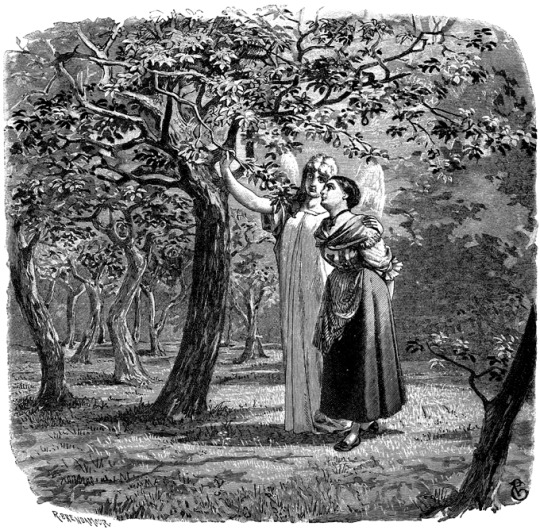
The girl without hands (Das Mädchen ohne Hände)
This fairytale is actually a cross between the AT type 706 "The maiden without hands" and the AT 930 "Urie's letter/The prophecy". The story was created by the brothers mixing two versions from Hesse, one told by Mary Hassenpflug, the other by Dorothea Viehmann. The second version lacks this story's introduction and begins with a father trying to marry his own daughter - when she refuses, he cuts off her hands and breasts, and chases her out of his house. It then follows the story. Meanwhile, the first version differs when the heroine is with her child in the forest: an old man tells her to hug three time a tree with her arms, which makes her hands grow again. He also tells her to only open the door of her house to one who will ask to enter "for the love of God" three times in a row - the king will be forced to do this before entering.
Outside of these two main versions, the brothers Grimm collected three additional ones. In the first, the angel that guides the girl is replaced by a small light that descends from the sky ; and the hands of the girl grow back when she plunges her arms in a stream after seeing a blind mouse enter its water to regain its sight. In the second version, a man is upset at his little girl praying for him day and night, but since she refuses to stop despite his demands, he cuts off her tongue. But she prays in thought and makes the sign of the cross, so he cuts off her right hand, then her arm all the way to the elbow, before banishing her. She is saved by a hunter that hides her in his master's domain and feeds her in secret with his master's dogs. When the master discovers this, he decides to raise the girl as his own child. One day she gives money to a poor man, who tells her she will regain her arm and tongue if she goes to drink of a certain stream, and he gives her a magical staff to protect her. When she returns at the lord's house, he marries her. The third version is about a queen banished by her husband with her two children, and is identical to the legend of saint Helen.
Other international versions of the tale include Zingerle's "The pretty daughter of the innkeeper", Basile's "Penta the one-armed girl" and Afanassiev's "The young girl without hands". There are some versions where it is a man that is mutlated, such as Afanassiev's "The brave without legs and the blind brave". The roots of this story date back to the end of the 12th century, and are located in southern England - this tale was the subject of numerous literary adaptations, the most famous being the verse romance of the 13th century "The Beautiful Helen of Constantinople".
The motif of the child sold to the devil is recurring among the Grimm fairytales - even though the character of the devil can be replaced by another supernatural being, such as in "Rapunzel" or "The Nixie of the Mill-Pond". The idea of offering the first thing one sees upon returning home is as old as the Ancient Testament (Judges). This story bears the signs of a heavy Christianiation, and was clearly inspired by the legend of Saint Genevieve of Brabant, falsefely accused of being unfaithful and condemned to death with her newborn child. The executioners take pity on her and she lives alone in the woods for seven years. As with other tales from the Grimm collection, this story mixes the Christian fantasy (the hands that regrow are treated as a Christian miracle) with pagan fantasy (there are several elements of folk-magic, such as the circle the girl draws around her to be protected from the devil, or the accusations of the queen giving birth to a changeling - a changeling also appears in the third story of "The Elves", KHM 39).

The Robber Bridegroom (Der Räuberbräutigam)
This story belongs to the fairytale type Aa-Th 955, named after it: "The robber bridegroom".
The tale was told to Jacob Grimm by Mary Hassenpflug, and was present as early as the 1810 manuscript. However this first version, that the brothers deemed "incomplete" was replaced from the 1812 edition onward by a new version which mixed two versions from Lower-Hesse. The brothers noted the existence of another version where the robber indicated the road to his house to a princess, by tying ribbons around the trees.
Ludwig Bechstein took inspiration from the brothers Grimm's tale to create his own "The Robber Bridegroom". This fairytale, like "Fichter's Bird", belongs to the "Bluebeard cycle" (several tales that the brothers removed from their first edition also belonged to this cycle).
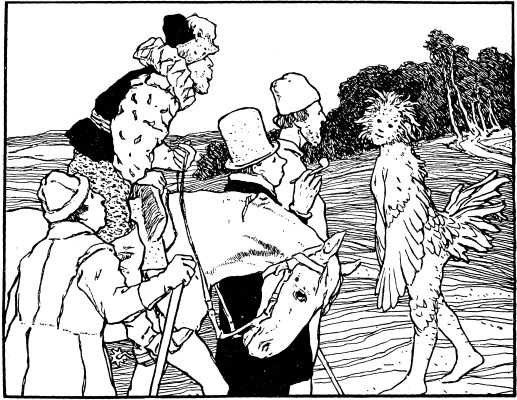
Fitcher's Bird (Fitchers Vogel)
This tale is a variation of the Aa-Th 311 "The heroine rescues herself and her sisters", usually classified under the "Bluebeard" category.
The final text of the Grimms is actually a mix of two different versions of the same story that was told to the brothers by both Friedrike Mannel and Dortchen Wild. The Grimms noted the existence of a version from Hanovre which goes as follow: a poor woodcutter asks his daughter to bring him his meal in the forest, and to show them the way he places peas on the floor. However dwarves notice this, and change the emplacement of the pea so that their path leads to their grotto. The older girl follows the peas, and become the dwarves' slave. Then we have the Bluebeard "forbidden room" motif, and the story goes as the "Fitcher's Bird" goes, as the dwarves lure the two other sisters to their cave. The last sister sticks the feathers on her body by rolling herself in blood (presumably the blood of the dwarves' victims), and there is no resurrection of the sisters. Everybody that meets her on the way call her "geputzter Vogel". The dwarves hunt the girl down and almost catch her just as she reaches her father's house - she is so fast in closing the door that it cuts a piece of her heel. The Grimms also knew of a Dutch version of the story, translated in German, and that was identical to one of their first-editions tales, "The Murder-Castle".
The translation of the name of the "bird" always caused many problems, due to the difficulty of understanding the expression. The brothers Grimm themselves explained the name of the bird by the Icelandic "Fitfuglar", meaning "birds that swim" - as such, the girl would be called "Fitchers-Vogel" because she looks like a swan". However, other people do not agree with this etymology, some linking Fitcher with "Fitze", the thread. Rimasson-Fertin highlights that the expression "Fitchers Fitze", outside of a simple sonority game, might be two variations of the male name Fritz (the diminutive of Friedrich) - other usual diminutives were Fitze, Fitz and Fiete. The brothers Grimm noted that the motif of the blood that cannot be erased was much older than Perrault's Bluebeard - it could be found as early as the "Gesta Romanorum", where a mother who had murdered her child couldn't erase three blood-drops from her hand, forcing her to wear a glove. This story must be compared to the KHM 40, "The Robber Bridegroom".
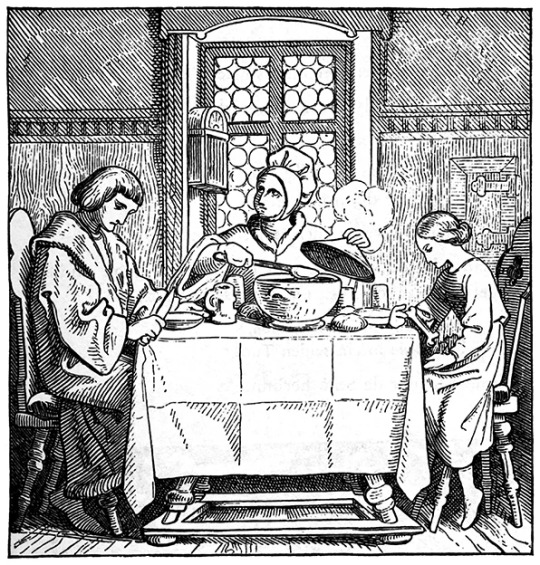
The Juniper Tree (Von dem Machandelboom)
It is the AaTh 720 "My mother killed me, my father ate me".
Just like the tale of "The Fisherman and his wife", this story was written by the painter P. O. Runge, and the brothers Grimm used it as a model for how they should present their own fairy tales. In fact, we can note sentences almost identical between the two tales.
The brothers noted a variation of the story where the stepmother places her daughter near the pot where her brother cooks, and she forbids her from looking inside. But since the pot boils too much, the girl lifts the lid - then her brother's hand reaches out to her from the cauldron. There is yet another version noted by the Grimm where there are three children, not two, and the stepmother sends them pick up strawberries in the wood, promising an apple to whoever comes back first.
The cruelty of this fairytale earned the brothers a serious criticism from Achim von Arnim - who only tolerated such violence because it echoed the one present in Goethe's Faust. The description "red as blood, white as snow" of course echoes the tale of "Snow-White". The brothers Grimm mentionned in their notes that the juniper tree was a plant believed to have the power to bring back youth - and Rölleke noted that the juniper-tree's red berries were used in folk-magic. It seems to be a very ancient tale due to several very old motifs such as the soul returning in the shape of a bird, a resurrection out of bones, and cannibalism. This tale must be compared to "Brother Lustig", "The Singing Bone" and, of course, "The Fisherman and his wife".

Briar Rose (Dornröschen)
Of course, it is the AaTh 410 "Sleeping Beauty".
This fairytale was present as early as the 1810 manuscript, written by Jacob Grimm from a tale told by Marie Hassenpflug. Research has proven that this story is derived from Charles Perrault's own Sleeping Beauty. We also find back in the German story a motif coming from another famous French literary fairytale, madame d'Aulnoy's "The Hind in the Woods/The Doe in the Woods" (also known as the White Doe). In this story a Crayfish/Lobster fairy announces to the queen she will have a child, and later the same fairy curses the princess as she is born - and what a coincidence! In the first edition of "Briar Rose", the animal that announces the princess' birth is not a frog... but a crayfish. Proving that there is a direct link. As for the name of the princess n German, "Dornröschen", "small briar rose", it actually first appeared in the German translation of a 1730 fairytale by Anthony Hamilton (an Irish man who however spoke and wrote French), "Fleur d'épine" (Thorn flower/Briar flower) - it had been translated in 1790. Bolte and Polivka have also noted a comedy by Gryphius from 1660 whch was named "Die geliebte Dornrose", "The beloved briar rose".
In their notes about the fairytale, the Grimm brothers explicitely compare Briar Rose to the legend of Brunhild asleep behind a wall of fire, cursed into a magical slumber by Odin's "sleep-thorn" and woken up by Sigurd, the only one able to cross the wall of flames. The brothers Grimm were also aware of Basile's version of the story, "Thalia, Sun and Moon", which they compared to their own Briar Rose in their notes. The brothers were very fascinated by the consistant naming of the princess' children from Perrault (Dawn, Day) to Basile (Sun, Moon) and compared it to the occurences of "Day, Sun and Moon" as names within the Eddas. However we know that Perrault was heavily inspired by Basile's story when writing his own Sleeping Beauty, and only modified some parts so as to erase the more shocking and "unpleasant" parts (such as the married prince having sex with the sleeping girl). Of course, this story is also to be compared with the 14th century medieval tale of the Roman de Perceforest.
The wise women that appear in this story are the Germanic equivalent of the fairies. In fact, we know that the brothers Grimm carefully avoided (or erased) any mention of "Fee" (the German word for the English "fairy" and French "fée") from their tales, so as to better differentiate them from the French "fairy tales", "contes de fées". By turning the fairies into wise women making predictions at the child's birth, the Grimms notably opened an entire set of symbolism and interpretations linking them to the mythological figures of the Norns, Parcae and Moirai.
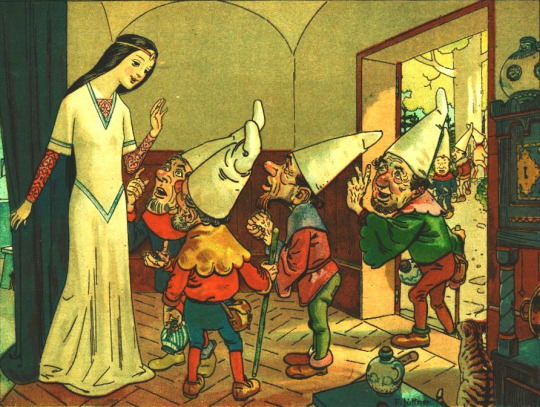
Snow White (Schneewittchen)
Of course, it is the AaTh 709 "Snow-White".
The full editing history of this tale was only "recently" recreated (the book was published in 2009, it was recent back then) in its entirety. We know that it begins in 1808 with a version collected by Ferdinand Grimm, brother of Jacob and Wilhelm, called "Schneeweibchen". It seems Ferdinand might have invented the story on his own. Wilhelm and Jacob then slowly modified it, by adding details from other collected versions, before publishing it in their first edition in 1810 (they did note at the time that it was a Lower-Germany story, and that in Upper-Germany the tale did exist but with the deformed name of "Schliwitchen". When the Grimms did their second edition, the main change they performed onto this story was the modification of the wicked mother into a wicked stepmother - something they also did for "Hansel and Gretel". In fact, from edition to edition the Grimms kept adding adjectives and expressons highlighting the opposition between the girl and the vain queen.
Th Grimms had collected several variations of the tale. One was much closer to the tale of "The Juniper Tree" and in it the queen, as she was with the king on a hunting sled, cut her finger while peeling an apple. In another variation the king and queen were walking by three mounts of snow, than went by three pools of blood, and finally saw three ravens in the sky, and each time the king wishes for a girl with the corresponding colors - soon afterward the couple encountered a little girl fitting this description. The king, immediately attached to her, takes her with him in their royal carriage, but the queen immediately hates her and tries to get rid of her - so she asks the girl to go seek a glove she threw out of the window, and while she is out of the carriage she asks the driver to leave as fast as he can. Then the little girl takes refuge at the seven dwarves' house.
The fairytale existed in German literature before the brothers Grimm published it. Indeed J. A. Musaüs had published in 1782 a fairytale called "Richilde" - and the Grimm were influenced by this tale, since in the margins of their first edition, they noted about Snow-White "It is Musaüs' Richilde". There was also a Snow-White story that had been published in 1809 in a fairytale book by A. L. Grimm (no relationship to the brothers Grimm). The Brothers Grimm did note the striking similarity between this story and the Norse pseudo-historical legend of Snäsridr, the beautiful wife of "Harald with fair hair", a wife that, when she died, stayed in her prime state so that it seemed she was still alive.
This fairy-tale has a very wide area of spreading, as it can be found from Ireland to Turkey passing by central Africa. It is especially present in the literary Italian compilations of fairytales. Basile has three variations of the story in his Pentamerone: "The raven", "Nennillo and Nennella" as well as "The she-cook".
The various virtues that Snow-White shows in this tale made her one of the big role models within the education of bourgeoisie girls in the 19th century - alongside Cinderella, of course. In fact, according to H-J Uther's analysis of the story, it is because of all her virtues that Snow-White's beauty does not fade away and stays undamaged even in death, unlike her wicked stepmother whose vices causes the fading of her charms. Finally, this fairytale is actually the proof that the brothers Grimm did not simply listed their fairytales one after the other in a random order, but deliberately created "bridges" and internal references to create a cohesive world within their book. Indeed, the mention of the snowflakes looking like feathers references "Frau Holle", while the glass coffin can be found back in, of course, "The Glass Coffin", and the blood-drops on the snow evokes "The Juniper Tree".
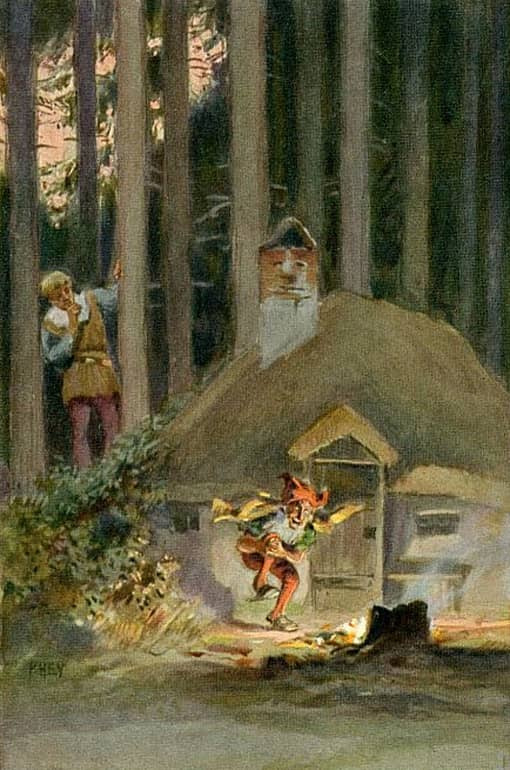
Rumpelstilzchen
Yes this story is the famous "Rumpelstilskin" (or Rumpelstiltskin? I never know how to write it in English). But why keep the German spelling? Because Rimasson-Fertin has some stuff to say about it: this name is the diminutive form of "Rumpelstilz", a term that Jacob Grimm defined in his "German Dictionary" as being synonymous with "poltergeist" (he noted a similarity between Poltergeist and Rumpelgeist, both designated a very loud spirit). While today "poltergeist" is mostly associated with ghosts, in a much broader way it designate a dwarf, a dead or a devil - or just any kind of phenomenon caused by witchcraft.
This story corresponds to the AaTh 500 "The name of the supernatural being". This fairytale has an interesting evolution history... Jacob Grimm had a version of it as early as 1808, named "Rumpenstünzchen", which was then slightly modified for the 1810 manuscript. This tale was actually the mix of two different versions - and one of these versions had a different ending. The queen didn't sent messengers searching for the dwarf's name, rather the king spotted the little man while returning from hunting on the third day. The Grimm also noted a variation where the initial situation was reversed: a young girl who had to spin hemp but could only manage to spin gold much to everybody's despair, and a small man appeared to promise her a wedding to a king's son in exchange for her firstborn child. It ended in such a way: the queen herself spotted the small man singing his name, jumping around a fire while riding a ladle like a horse. When she guessed his name, he flew out of the window and into the sky, riding the ladle like a witch's broom. We know that the episode of the spinning of the straw was only added by the Grimm in 1812 (it is not in the 1810 version), and that the final scene of the dwarf self-mutilating comes from a story of Lisette Wild and was added in 1819.
The first literary record of this story is a French fairytale published in 1705 and written by Mlle Marie-Jeanne L'Héritier de Villandon. It was "L'Histoire de Ricdin-Ricdon" (The Tale of Ricdin-Ricdon), published in her "La Tour ténébreuse et les jours lumineux" (The Shadowy tower and the luminous days). It had been translated in German by Johann Gottwert Müller in 1790, under the title "Straubfedern", "Ostrich feathers". As for the name "Rumpelstilzchen", it actually originates from Johann Fischart's Grman adaptation of the French "Gargantua", "Geschichtklitterung" (1584) - in it, Fischart lists various children game by name, and mentions a "Rumpele stilt oder der Poppart".
This fairytale type is very present in Western, Central and Northern Europe (British Isles and Ireland included), with also a few spottings in the Baltic countries, China and Japan. The name of the supernatural being always changes from one region or country to the next (in Swiss it is Hans-Öfeli, in Dutch Trillevip, in Swedish Titteliture, in Finnish Tuttirituli, in the Suffolk it is Tom Tit Tot, in Welsh Gnarwynathrot, in Irish it is Eve-Trot or Trit-a-Trot...). It is part of the enormous success of this tale-type: every country has to invent its own brand of nonsensical, un-guessable name. As for the rhymed song through which the dwarf betrays its name, it is found in England as "Nimmy nimmy not / My name is Tom Tit Tot", and in an Afro-American version of North Carolina "I'm so glad that she do not know / That my name is Tabutoe Tambutoe".
The brothers Grimm noted that in Germanic mythology it was typical for underground beings (aka dwarfs) to have names that are not usual among humankind, which is why, again according to them, the dwarf of this story would feel in perfect safety proposing the queen such a game. The rule according to which obtaining the name of a supernatural being means gaining a form of power over them is very common, and is even reused in another one of the Grimm stories: KHM 136, "Iron John". H. Rölleke did an analysis of the names the queen proposes at first: we have the three names of the Magi, aka the Three Wise Men, or King-Magi, which gives a Christian setting to the story, and could also serve as a metonymy for all the saint names found in the Christian calendar. As for "Heinz" and "Kunz", Rölleke sees in them the diminutives of the names of the medieval emperors Heinrich and Konrad, which used to be some of the most popular male names among German-speaking countries.
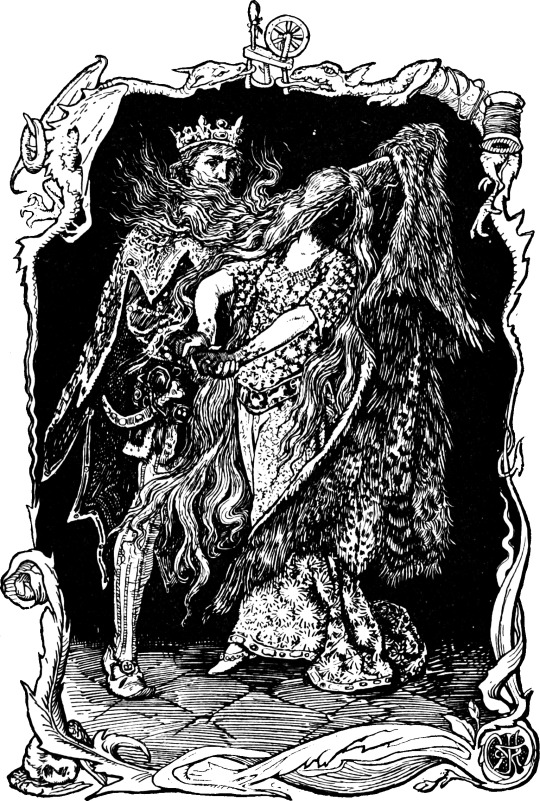
All-Kinds-of-Fur (Allerleirauh)
It corresponds to the AaTh 510B "The dresses of gold, silver and stars", also known as "Donkey Skin", after the famous Charles Perrault fairytales.
The story we read today was the one told to the Grimm by Dortchen Wild, but there was a variation of it told to the brothers by Jeannette Hassenpflug, "Princess Mouse-Skin", which was present in the 1812's edition of the volume (n°71) but was then moves to the annotations as a mere mention. The version of the story from the first draft (the 1810 manuscript) was called "Allerlei Rauch", "All Kinds of Smoke", and was heavily inspired by one of the tales present within the novel "Schilly" by Carl Nehrlich.
The line "God forbade a father from marrying his daughter. Nothing good can come from this sin which will cause the kingdom's decadence" was added in the 1819 edition, and references a tale of Albert Ludwig Grimm called "Brunnenhold und Brunnenstark". The brothers Grimm insisted even more on the condamnation of the sin of incest when rewriting the story for their "small collection" for kids, and also insisted heavily upon a political extension of such a decision, which would damage the state itself. It is actually an allussion to the failure of the Frankfort Parliament, which had been gathered in 1848 at the Paulskirche in an attempt to create a constitution for all of Germany - to which Jacob Grimm had taken part.
A variation of the story collected in Paderborn has the last coat made of all the furs of the kingdom, plus moss and various forest-related material. In this version, the heroine puts the cloak on top of her three beautiful dresses before fleeing, and she hides in an empty tree where she is discovered, not during a hunting party, but by woodsman that cut off the tree she was sleeping into, to bring wood to the king. All-Kinds-of-Fur works in the castle's kitchen but one day as she is preparing the soup, the king has her sit on his chair so she can delouse him (a motif also present in "The Devil with Three Golden Hair). As she does, the king glimpses the beautiful shining dress under the cloak's sleeve, and this is how he discovers the girl's true appearance. Another variation of the story yet, also collected in Paderborn, has the heroine pretending to be mute. One day the king hits her with a whip, it rips apart the coat, revealing the golden dress underneath.
Not all the German versions of the story include the incest motif. In Musaüs' take on the story, "Die Nymphe des Brunnens", "The Nymph of the Well", the heroine leaves her father's castle because it has been destroyed. Her godmother, an undine, gifts her a small magical box and when she leaves the ball she says "Night behind me and day before me / Might nobody see me!". As for the version of Hassenpflug, "Princess Mouse-Skin", it begins as the KHM 179, "The Goose-Girl at the Well": a king wants to know which of his three daughters love him the most, the first says she loves him more than the whole kingdom, the second more than pearls and precious stones, the third more than salt. The furious father has the last princess be sent into the woods to be killed, but the servant tasked with the execution spares her out of pity, and gives her, by her request, a coat made of mice skin. The rest of the story goes like within "All-Kinds-of-Fur", except for the final wedding, to which the father-king is invited. All the dishes served to him are without salt, and he ends up saying he prefers to die rather than continue eating without salt. The princess-daughter reveals herself and points out how he tried to had her killed for loving him more than salt. Her father begs her for forgiveness, and the tale ends with her accepting.
The motif of the incest can, however, be found back in a variation of the KHM 31 (The Girl Without Hands) that the Grimms collected, and where the father mutilates the daughter for refusing to marry him. The motif of the king trying to marry his own daughter has been attested in many, many European stories ever since the 12th century. As for the boots that are thrown in the heroine's face in the Grimm story, while in the final edition it has no follow-up, in the 1812 edition it was a recurring element forming a motif within the tale. Another German version of the story that preserved this structure that the Grimms erased is the story collected by Vernaleken, "Throw-Broom, Throw-Brush and Throw-Comb". In it the king throws out of anger at the face of the heroine (Adelaide) a broom, a brush and a comb. Every time she goes to the ball, she changes her pseudonym to fit which item hit her (one night she is "Throw-Broom", another she is "Throw-Brush", etc...). There are many, many variations of the story containing such a "name play".
Other famous examples of this variation, outside of Charles Perrault's Donkeyskin, include Straparola's "The maiden in the chest", Basile's "The She-Bear", Afanassiev's "Pig-Skin".
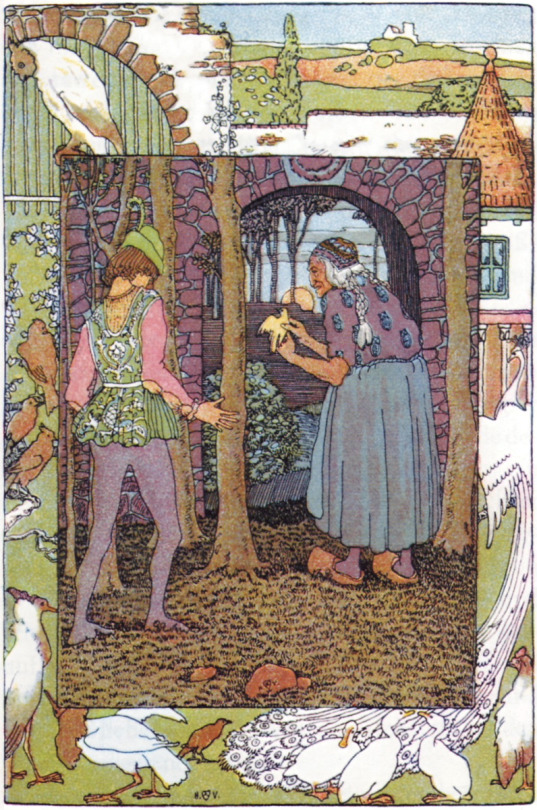
Jorinde and Joringel (Jorinde und Joringel)
It corresponds to the AaTH 405, named and created after this story, "Jorinde and Joringel".
The interesting thing with this story is that the brothers Grimm did not collect it from a direct source. Rather they lifted it, to the exact word, from the autobiography of Johann Heinrich Jung, "Jugend/Youth", published in 1779. The brothers deemed that the way Jung-Stilling had written the tale was the "perfect" way to tell the story, according to their definition of a fairytale. Though they did note the existence of a version of the story told in Schwalm - but which differs very little from the story of Jung-Stilling.
The brothers Grimm themselves noted a similarity between this story, and the KHM 123, "The Old Woman in the Wood". Rimasson-Fertin notes that the witch in this story is to be compared to the ones appearing in "Hansel and Gretel" and in "Little Brother and Little Sister". As for the name of the demon the witch invokes, "Zachiel", H. Rölleke identified it as a form of "Zachariel", a demon name coming from the very popular 17th century demonology grimoire "Clavicula Salomonis", "The Clavicles of Salomon".
#brothers grimm#grimm fairytales#brothers grimm fairytales#german fairytales#sleeping beauty#briar rose#snow-white#snow white#jorinde and joringel#all kinds of fur#the juniper tree#the devil with three golden hair#the three golden hair of the devil#the robber bridegroom#the maiden without hands#the girl without hands
45 notes
·
View notes
Photo

73 notes
·
View notes